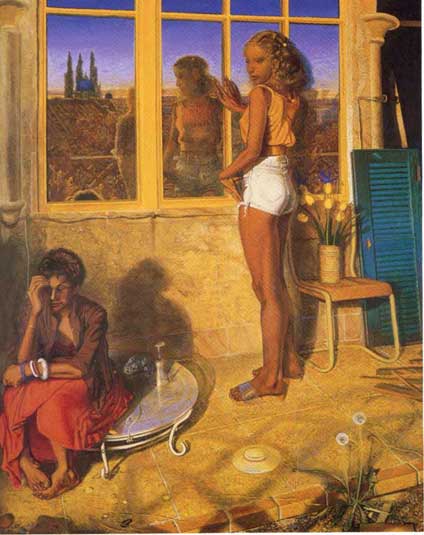 |
|
John B. Ravenal, from "Twenty Philadelphia Artists", Philadelphia Museum of Art, 1998
Over the past twenty years, Frank Galuszka's painting has ranged from detailed realism to thickly painted abstraction. Until the late 1980's his work involved lush narratives marked by vivid, saturated colors, fully modeled figues in convincing spaces, and detailed rendering of objects. These scenes mostly depict single or multiple figures either in interiors or in shallow stagelike foregrounds before glimpses into the distance. They are characterized by moods of stillness, as solitary figures seem to dream, watch, or wait. Communication between figures is caught in a moment of suspension, evident only in a glance or attitude of attention. These are narratives ripe with portent, as if the painting itself were thinking. In the late 1980's, the surface of galuszka's paintings began to break up into dense screens of brightly colored paint, what he calls "exploded cellular near-abstraction." While the predominant effect was that of paint - thick, intense accumulations - these works were never fully abstract, as they contained barely discernable representations of figures and objects, and collaged items such as a coffee-cup lid or bits of reflective mica that enhance the active, shimmering quality of the surface. The buildup of surface incident around these details of reality suggests analogues for an overstimulated vision, as if the image recorded a hallucinatory experience of the visible world.
Galuszka understands these two periods in his work as expressions of the same underlying concerns rather than a simple opposition of figuration and abstraction. In his early narrative works galuszka's carefully considered attention to form and composition gave them a highly constructed appearance, beyond an easy naturalism. In his later abstract paintings the elaborate working of every bit of the surface results in a high level of variety and intensity that leads us to ubderstand his abstract images as strongly allegorical and bursting with possible meanings. Work from the mid-1990's returns to naturalistic figures but places them in abstract settings, further complicating the idea of a linear progression from representational to nonobjective. Throughout his career, Galuszka's images have been motivated by textual associations. He often combines classical, mythological, and biblical sources with contemporary figures and settings. In Bethany, two women in modern dress allude to Mary and Martha from bethany, who in the biblical story called upon Jesus to raise their brother lazarus from the dead. In the painting, a man's reflection, perhaps alluding to the returning lazarus, appears in the window. As with many of Galuszka's works, an aura of the past seems to pervade, even comment on, the present, regardless of whether one grasps the narrative allusion. Galuszka says that he has his own " long reverie about what the painting is about É (but) this does not mean at all that I want anyone else to think that this is what the painting is about." He further explains, "I try to paint paintings that have enough ingredients in them to result in a good story, but not in such a way that they determine what the story is. For me, two readings of this painting are both equally legitimate."
- more -
© Frank Galuszka 2008